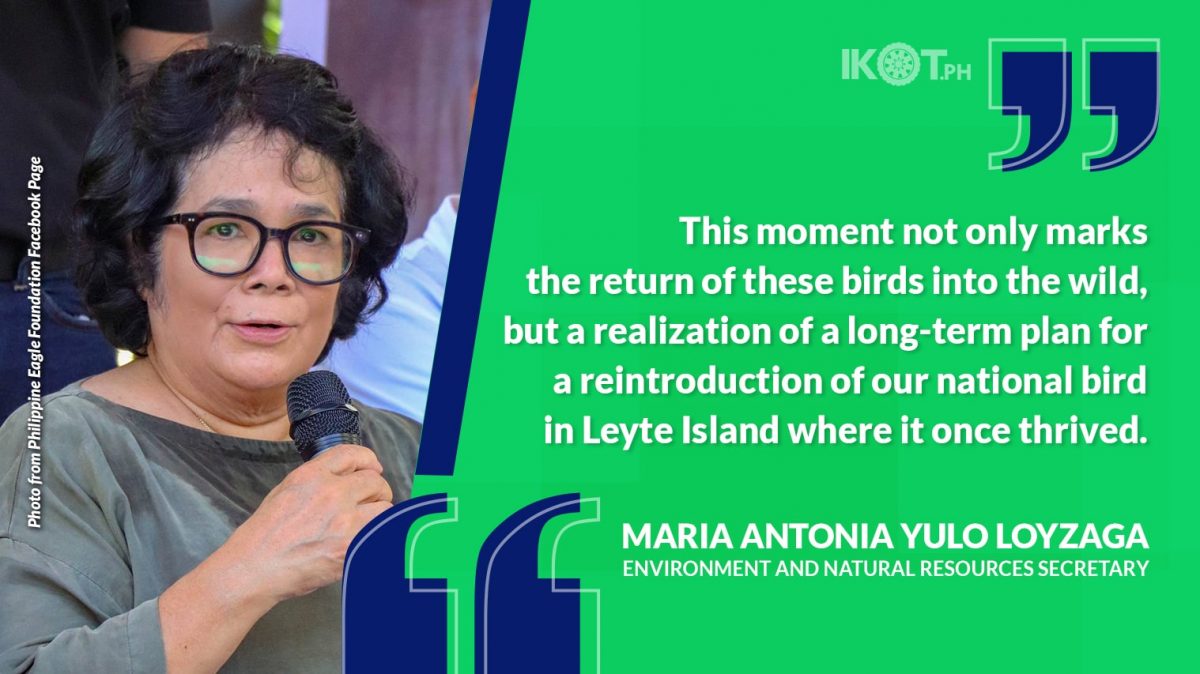In a bid to increase the population of the critically endangered Philippine eagle across the country, the Department of Environment and Natural Resources (DENR) and the Philippine Eagle Foundation (PEF) released two eagles from Mindanao to a prime eagle habitat in Burauen, Leyte province.
The ceremonial release was led by DENR Secretary Maria Antonia Yulo Loyzaga, First Secretary of the Australian Embassy to the Philippines Kathlyn Gonzales, Mohamed Bin Zayed Raptor Conservation Fund Chief Executive Officer Dr. Munir Virani, PEF Trustee and Insular Life Foundation Vice Chairman Raoul Littaua and PEF Executive Director Dennis I. Salvador.
They were welcomed by Burauen Mayor Juanito Renomeron.
The eagles named “Carlito” and “Uswag”, were airlifted from the Philippine Eagle Center in Mindanao on June 11 to their new home.
The eagles named “Carlito”, rescued in 2022, and “Uswag”, rescued in 2023, were airlifted from the Philippine Eagle Center in Mindanao on June 11 to their new home — the Marabong Watershed, Anonang Lobi Range Key Biodiversity Area in Barangay Kagbana, Burauen town of Leyte.
“This moment not only marks the return of these birds into the wild, but a realization of a long-term plan for a reintroduction of our national bird in Leyte Island where it once thrived,” Loyzaga said.
Both eagles were each fitted with a 70 gram-solar-powered GPS/GSM tracker for remote monitoring after their release. They were given a clean bill of health after a general medical check-up last February.
With the scientific name: Pithecophaga jefferyi, the Philippine eagle got its official name following a 1978 order issued by the late President Marcos and was proclaimed as the national bird in 1995 by former President Ramos. The Philippine eagle is now a national symbol of cultural and heritage.
“Leyte is one of only four islands where Philippine eagles are recorded.”
According to PEF, Leyte is one of only four islands where Philippine eagles are recorded. Eagle records on the island were scarce, with no eagles seen or reported after super typhoon Yolanda in 2013. “It appears that the eagles have been extirpated in Leyte,” PEF’s Dr. Jayson Ibañez said.
However, the island still has 91,000 hectares of suitable eagle habitats in two Key Biodiversity Areas (KBA). To help secure these eagle habitats, DENR, PEF and their partners invested on building awareness and networks with key stakeholders (e.g. local government units, academic institutions, civil society groups and local communities) to protect its forest and prepare it for future eagle releases.
To care for the two Philippine eagles, PEF said it would organize, train and engage at least 25 local forest guards to help with the release and post-release activities; and conduct behavioral change campaigns with communities close to the dispersal or temporary settlement areas of the released eagles, as needed.
At least 25 local forest guards (FGs) from Barangay Kagbana in Burauen — the host community to the release– will be re-trained, deputized and engaged as Wildlife Enforcement Officers (WEO) by the DENR and PEF.
The forest guards will also follow the trail of the eagles after they are released, provide food/prey supplements when needed, and conduct education campaigns among residents living close to the eagle’s location.


